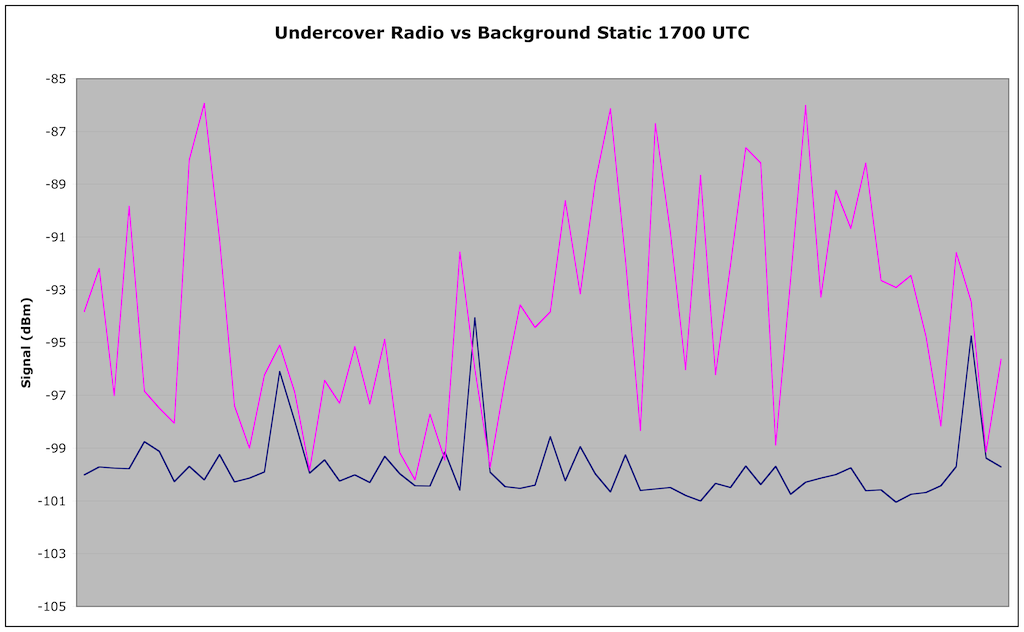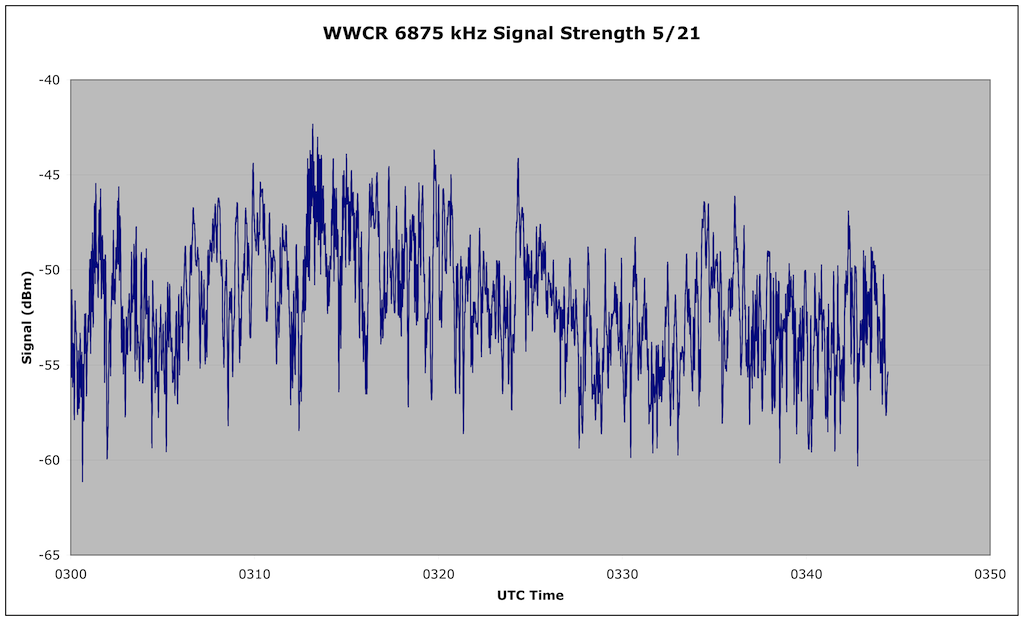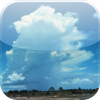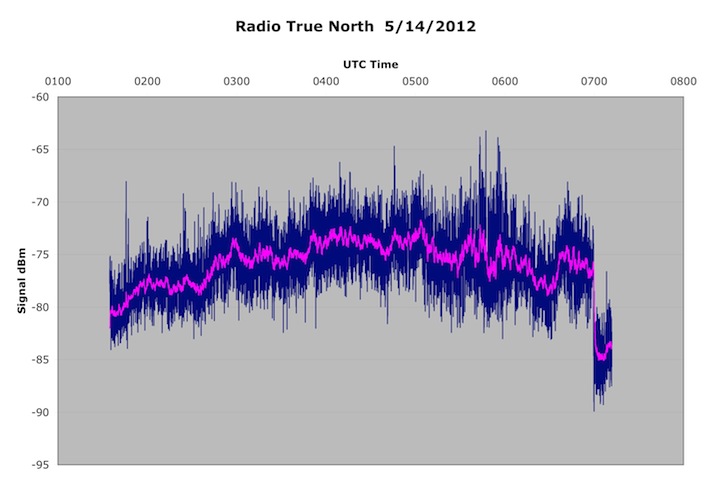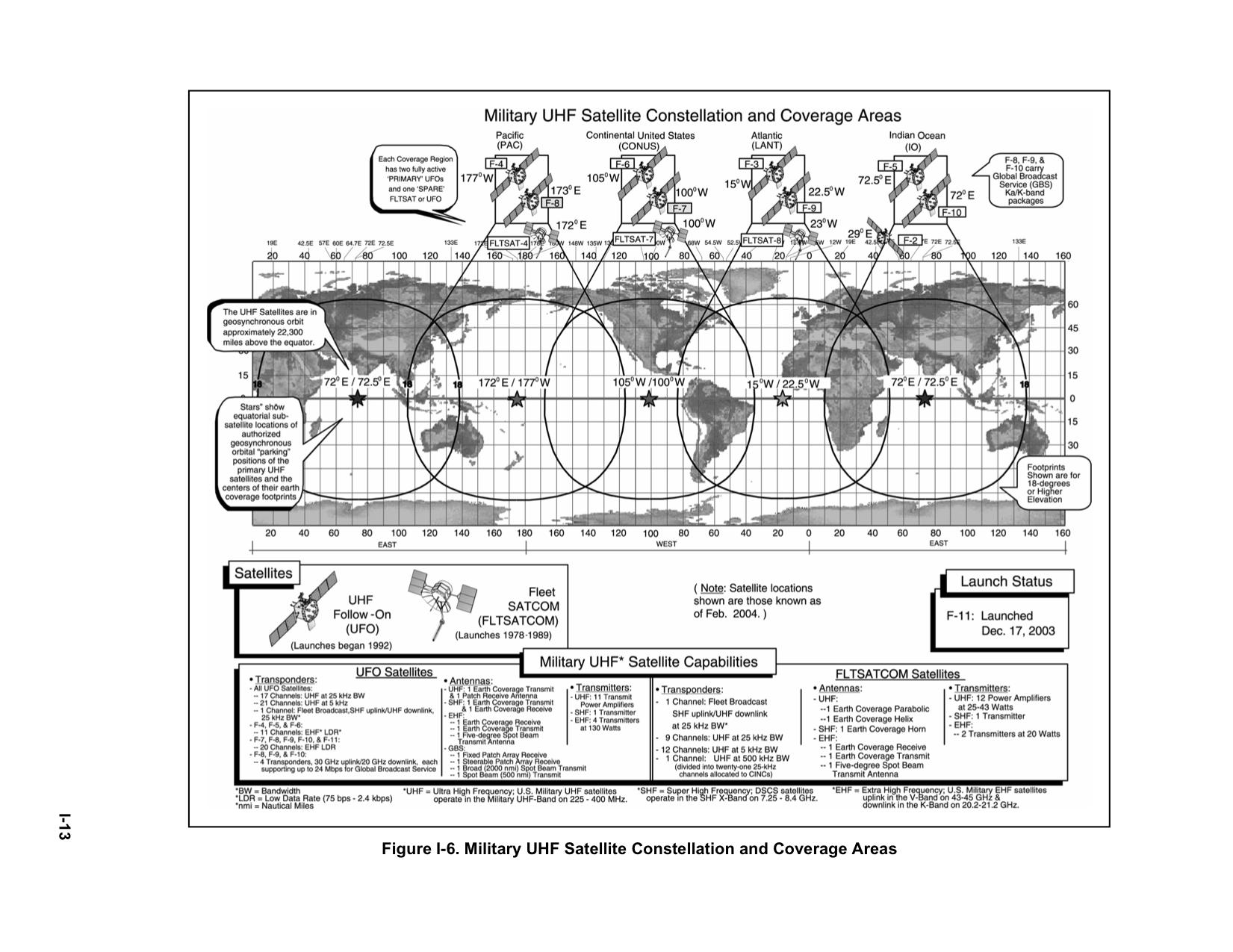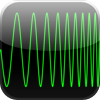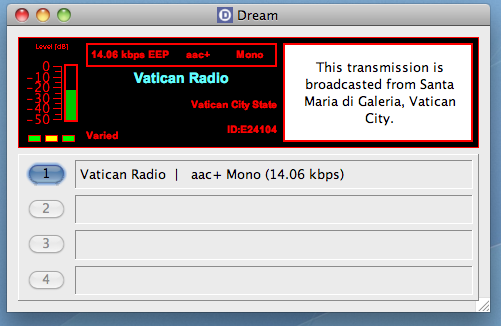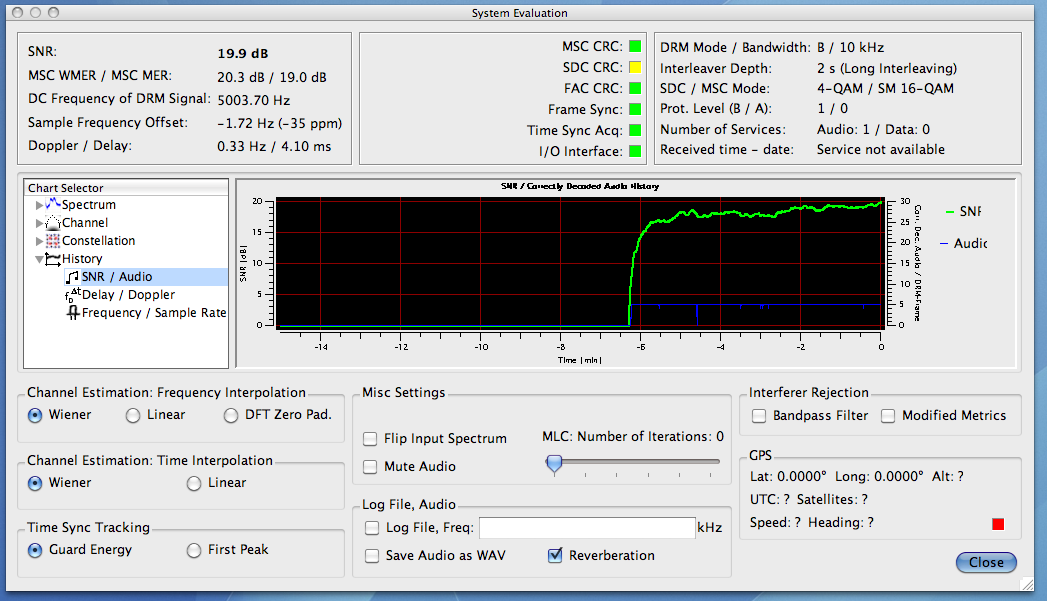An LED (Light Emitting Diode) connected across the coax transmission line from my 635 ft sky loop antenna, during a thunderstorm. You can see the LED flashing with the lightning strikes.
Monthly Archives: May 2012
Daytime Vs Nighttime Static Levels And The Impact On Reception
Undercover Radio was on 6925 kHz USB several times on Sunday, May 20, 2012, conducting some transmitter tests in the afternoon, and with a show in the evening. I noticed how, even with a relatively weak signal strength in the afternoon, the overall reception was still good, due to the low daytime noise levels on the 43 meter band. Transmitter power was around 20-30 watts PEP.
Here is a graph showing the signal level of Undercover Radio on 6925 kHz, as well as background noise from an otherwise unoccupied adjacent frequency for 4 minutes, starting at 1700 UTC May 20, 2012:
Undercover Radio’s signal strength was about -92 dBm. Bear in mind that this was a voice only program with Dr. Benway talking, with frequent pauses in speech. Since this was an SSB transmission, the received signal level falls to the background noise level during pauses in speech.
The background static at 6930 kHz was -100 dBm
The net result is a signal to noise ratio of 8 dB, which is certainly adequate for fair to good reception.
Some recordings:
Undercover Radio 6925 kHz USB 1700 UTC
Background noise 6930 kHz USB 1700 UTC
Undercover Radio came back on at around 1900 UTC. Here is another comparison of Undercover’s signal vs background noise on 6932 kHz:
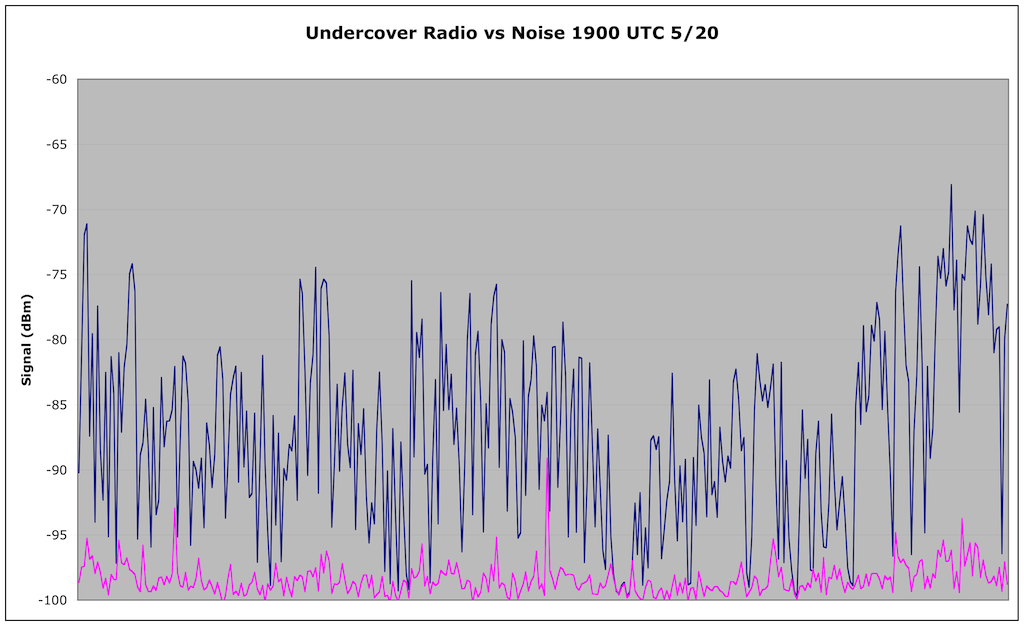
(Sorry, this time the noise is pink and the signal is blue. Just to keep you on your toes)
Eyeballing the graphs, it looks like the signal to noise ratio was about 15 dB, better than before. The quality of the received audio was indeed very good. Here is a recording
Next, Undercover Radio came on again at 0212 UTC.
The noise levels were around -85 dBm. Undercover Radio’s signal started at just around the noise level. At the time, he was running 20-30 watts PEP. Later, around 0245, Dr Benway realized he didn’t have the amp on, and then switched it on, going to 500-600 watts PEP.
One reason for the much higher nighttime noise levels is that not only is 43 meters open to DX from distant stations, but also to distant thunderstorms and other noise sources. Think of every thunderstorm in the world as a transmitter (which it really is). There’s thousands of active thunderstorms at any time, transmitting RF energy over the entire radio spectrum. This energy is received at your location from whatever parts of the world propagation is open to, on a given frequency. So while your signal can get out further at nighttime, it also has to compete with a lot more QRM sources.
During the daytime, the D layer of the ionosphere attenuates low angle radiation on 43 meters, preventing DX reception. You’re limited to just a few hundred miles. This applies both to the signals from radio stations that we want to hear, and distant noise sources.
Also notice how much Undercover Radio’s signal varied after the amp was switched on – by around 30 dB. That’s five S units! This tells us that signal reports, or even recordings, can be very hit or miss. One minute, an op can be at the noise level, a few minutes later, he can be many S units above it.
Two recordings. First, one from 0222 UTC when he was running 20-30 watts PEP, and the SNR was just a few dB. And second, one from 0300 UTC during a signal peak, when he was running 500-600 watts PEP, and the SNR was about 25 dB.
For comparison, here are some plots of WWCR, 6875 kHz, showing their signal level last night:
First, from 2230 to 0100 UTC (sorry for the X axis scaling, showing -100 for 2300 UTC. Blame Excel)
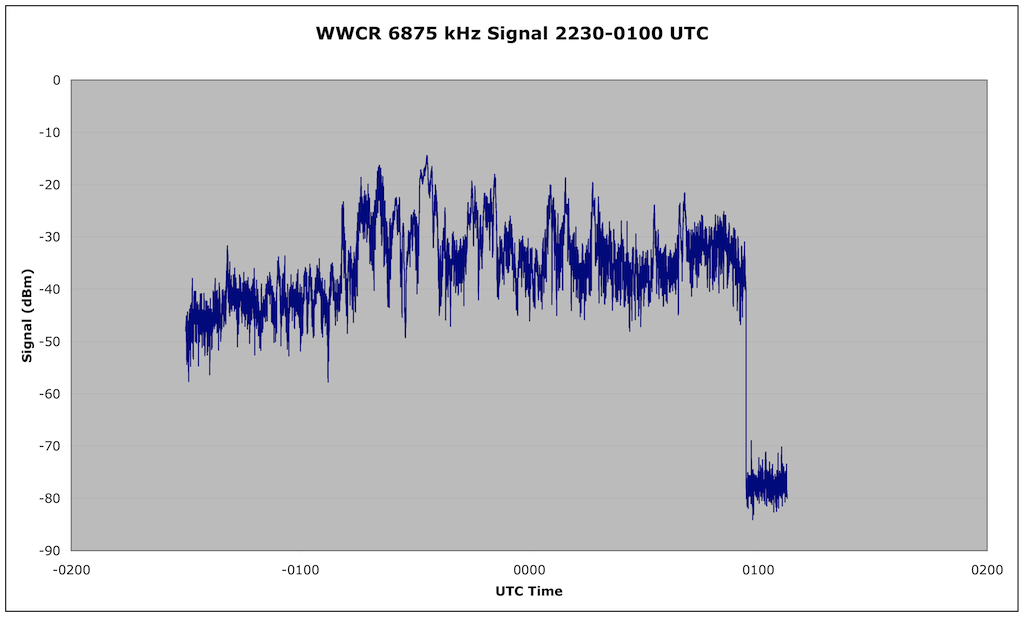
You can see that when their carrier went off the air, the noise level was around -80 dBm. And the signal varies by about 30 dB during the transmission, during nighttime. Earlier in the transmission, while it was still daytime, the signal was slightly weaker, but there was a lot less fading.
Perhaps the main point to take away from this is that while a pirate can be heard much further at nighttime than during the daytime on 43 meters, the lower noise levels and lack of significant fading during the daytime generally make for better quality reception, for those listeners within the several hundred mile NVIS range, and allows reception by listeners with more modest receiver/antenna setups. This is especially true when using lower power (grenade type) transmitters. Nighttime DX reception quality will be poorer, and limited to those with more substantial receiving stations. By selecting the time of day for operation, operators can to some degree select their audience and target area. A pair of transmissions, one in the daytime and one at night, would reach both local and DX listeners.
She had your dark suit in greasy wash water all year
An unidentified station was first noted at around 0330 UTC May 17, 2012, on 6990 kHz, sending three phrases over and over:
“She had your dark suit in greasy wash water all year. Don’t ask me to carry an oily rag like that. They used an aggressive policeman to flag thoughtless motorists”
I made this recording on 6990 kHz USB at 0041 UTC on May 17, 2012:
As of 2315 UTC on May 17, 2012, the station has moved to 6950 kHz USB, with the same repeated phrases.
Andrew Yoder reports hearing this same station on November 5, 2011 on 21450.7 kHz.
Some quick searches of the internet came up with something called the TIMIT Sentence Prompts.
According to Wikipedia:
TIMIT was designed to further acoustic-phonetic knowledge and automatic speech recognition systems. It was commissioned by DARPA and worked on by many sites, including Texas Instruments (TI) and Massachusetts Institute of Technology (MIT), hence the corpus’ name.
TIMIT consists of phrases of 630 speakers of of different sexes and eight major dialects of American English. The database is designed to assist in the development and testing of Automatic Speech Recognition systems.
There is an online listing of the phrases. According to that list, phrases 1, 2, and 437 are being sent.
Presumably someone is testing a system to perform automatic speech recognition on HF transmissions, and is conducting some real world test.
There is a thread of loggings of this station over at the HFUnderground Message Board.
I can only hope they don’t accidentally start transcribing 6925 kHz while Toynbee Radio is on the air. That could cause their computer to blow up, a la Kirk’s ability to make computers self destruct by confounding them with illogic on Star Trek.
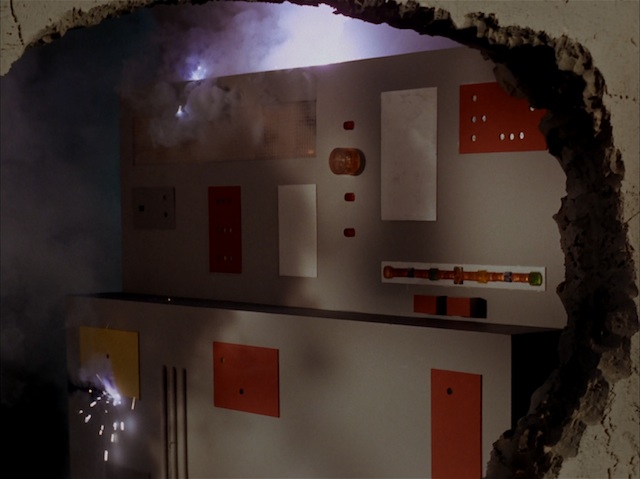
Some online references:
The DARPA TIMIT Speech Database for MastersThesis
The DARPA TIMIT Acoustic-Phonetic Continuous Speech Corpus
UPDATE:
Still going at 1128 UTC on 6950 USB.
Construction of a Helical Antenna for SATCOM Listening
Previously I wrote about the various kinds of transmissions you can heard on the 250 MHz SATCOM satellites. While you can pick these up with a standard scanner antenna, reception is much better with a directional antenna.
This page documents my project to construct a helical antenna for SATCOM listening, 240-270 MHz.
The antenna is based off the design found on this page, which has the specific dimensions and other technical details.
Here are the supplies:
Four 4 ft long strips of steel, four 5 ft long pieces of 1/2″ PVC pipe, one 5 ft long piece of 1 1/4″ PVC pipe for the boom, and window screening for the ground plane.
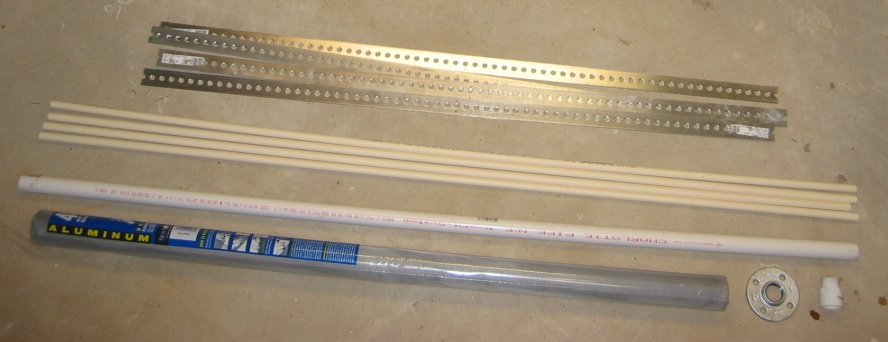
Here’s a close up of the flange and fitting for the PVC boom:
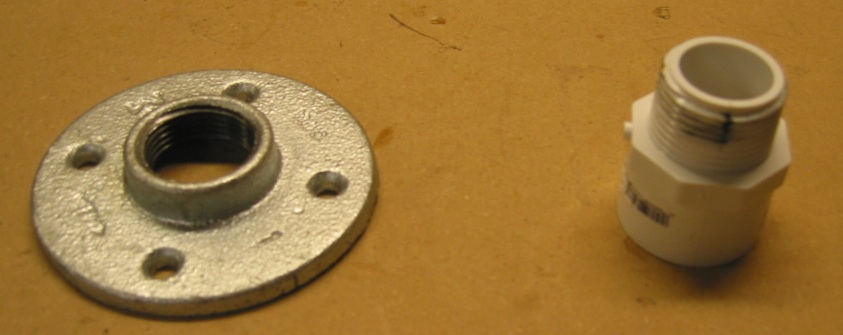
Here are the four steel strips arranged in the radial pattern:
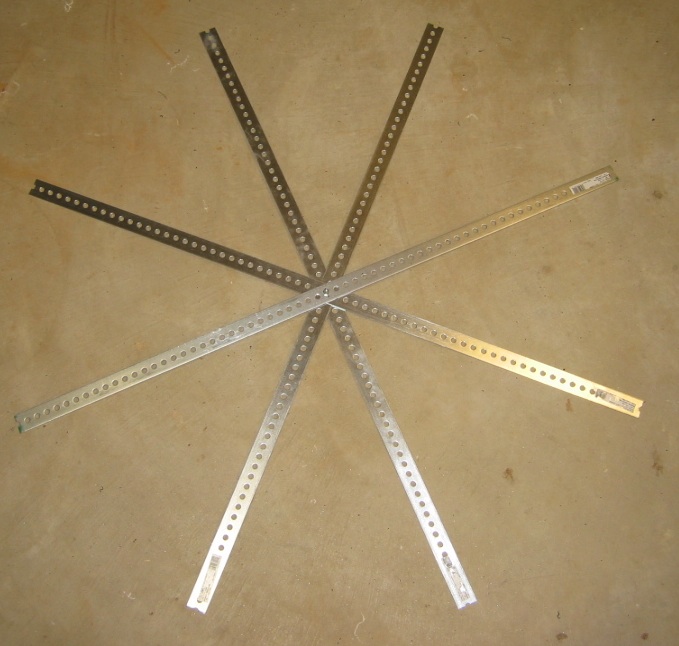
Next I drilled four additional holes in the flange, so it could be screwed to the eight radials:
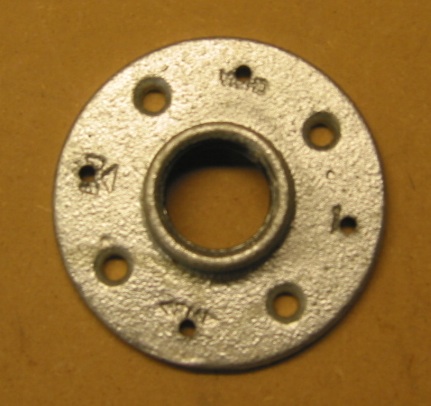
#10 hardware was used to attach it:
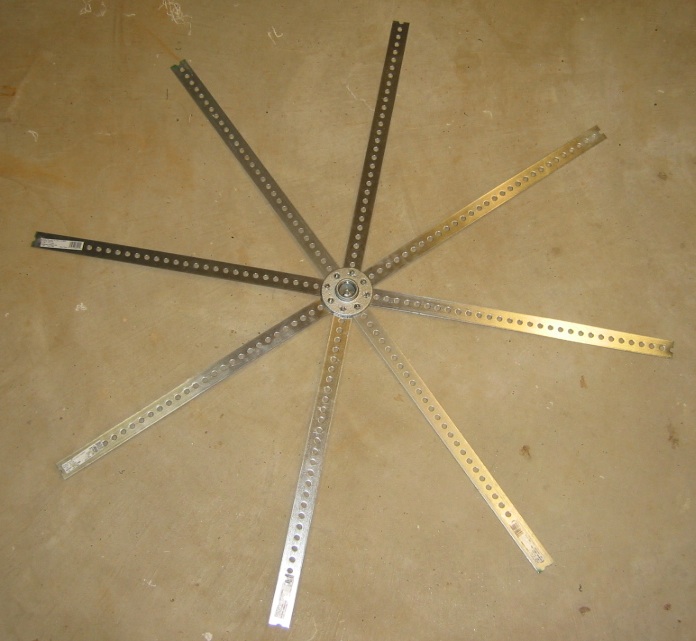
Here it is with the PVC boom attached, to see the overall size:
And now with the 20 supports for the tubing installed:
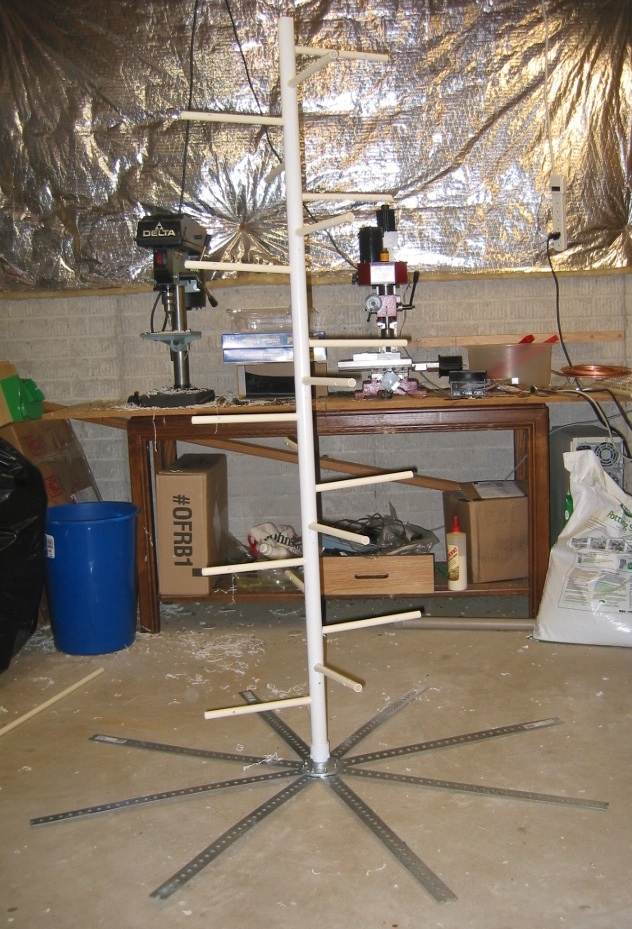
The tubing is 1/4 inch diameter:
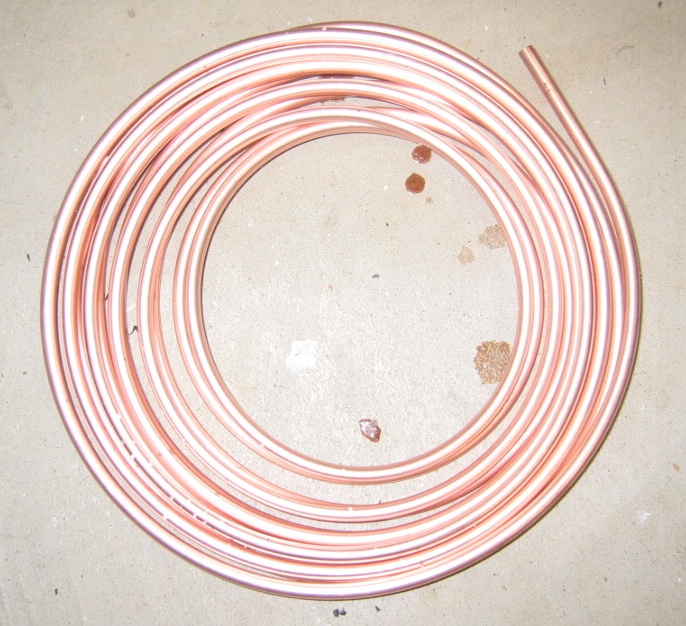
Here it is with the 5 turns of 1/4″ diameter tubing:
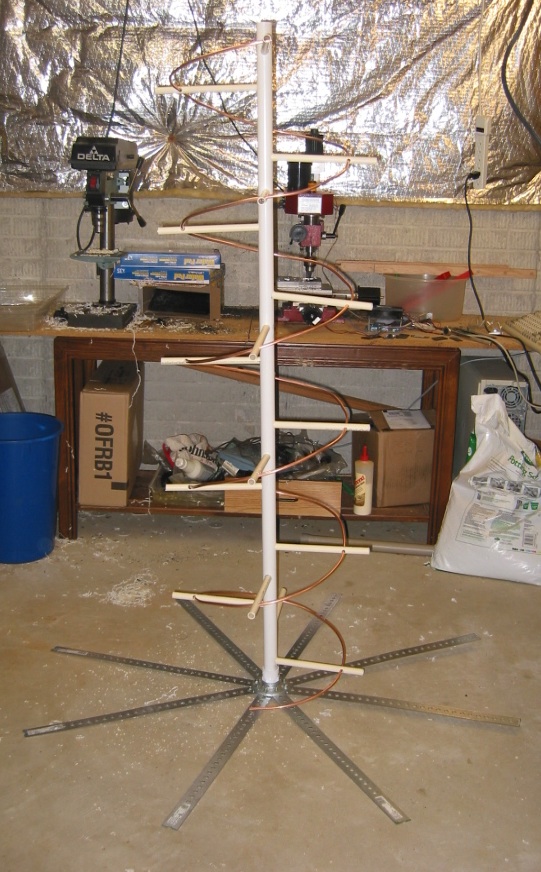
The screening has been added to the reflector. It is sandwiched between the strips for support:
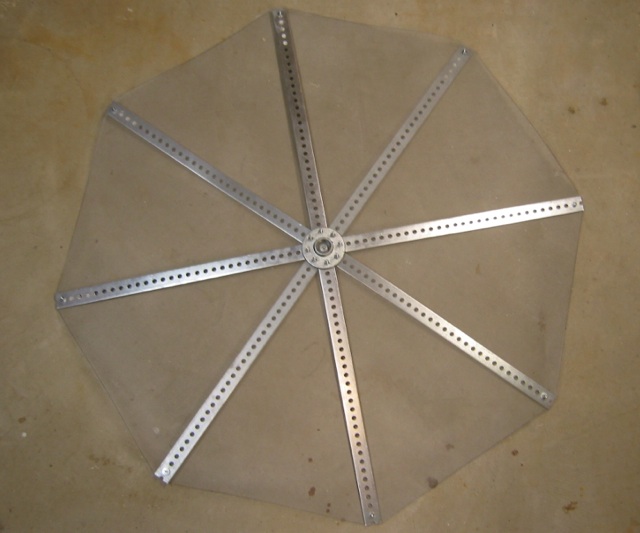
The [mostly] assembled helical antenna. The matching section is made from tin-plate and is cut to be a quarter of a turn, about 60mm wide. It’s soldered or bolted to the ground plane at the connector end, and supported by an adjustment screw at the other end. I’ve honestly not noticed much if any difference in the received signal, by fiddling with it. See http://www.uhf-satcom.com/uhf/uhfantenna.html for more details on the matching section.
Final assembly will be done outside, so everything is not tightly fastened yet:
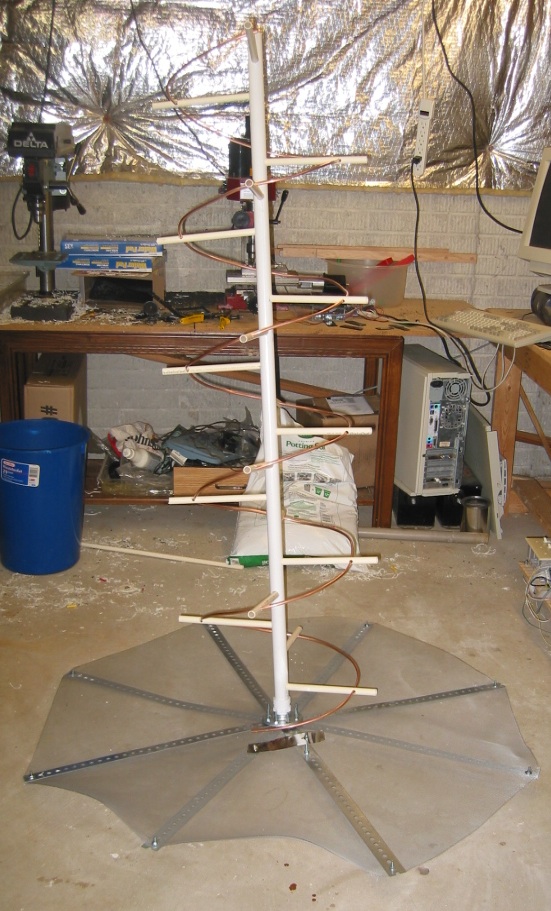
Here it is outside, mounted on a SG-9120 motor. The motor uses the DiSEqC protocol for control, which is sent over standard coax cable. It is a standard in the satellite TV industry.
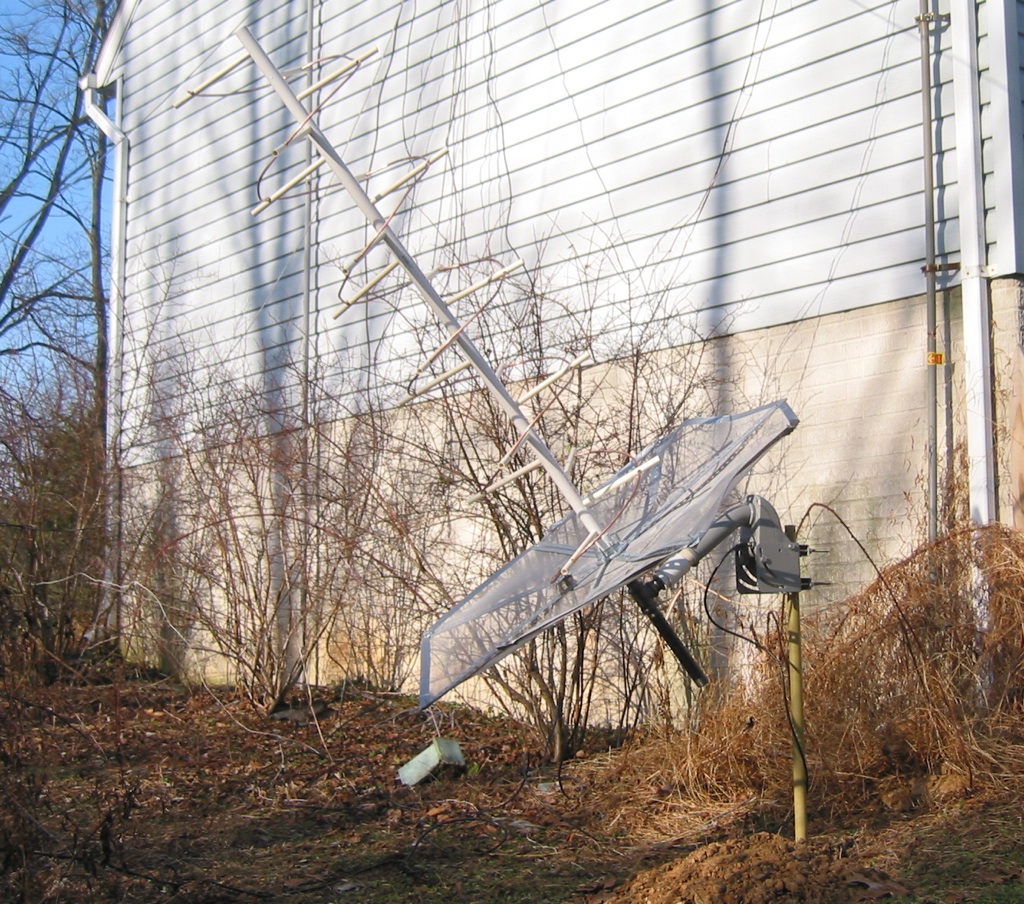
The motor is controlled by a Moteck digibox, which sits inside the shack:
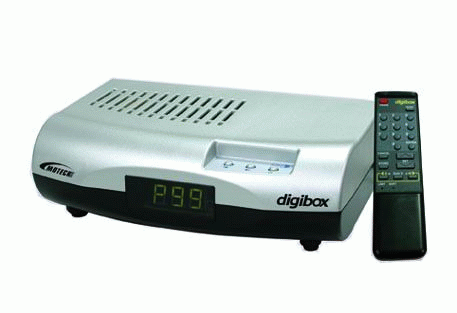
Another view:
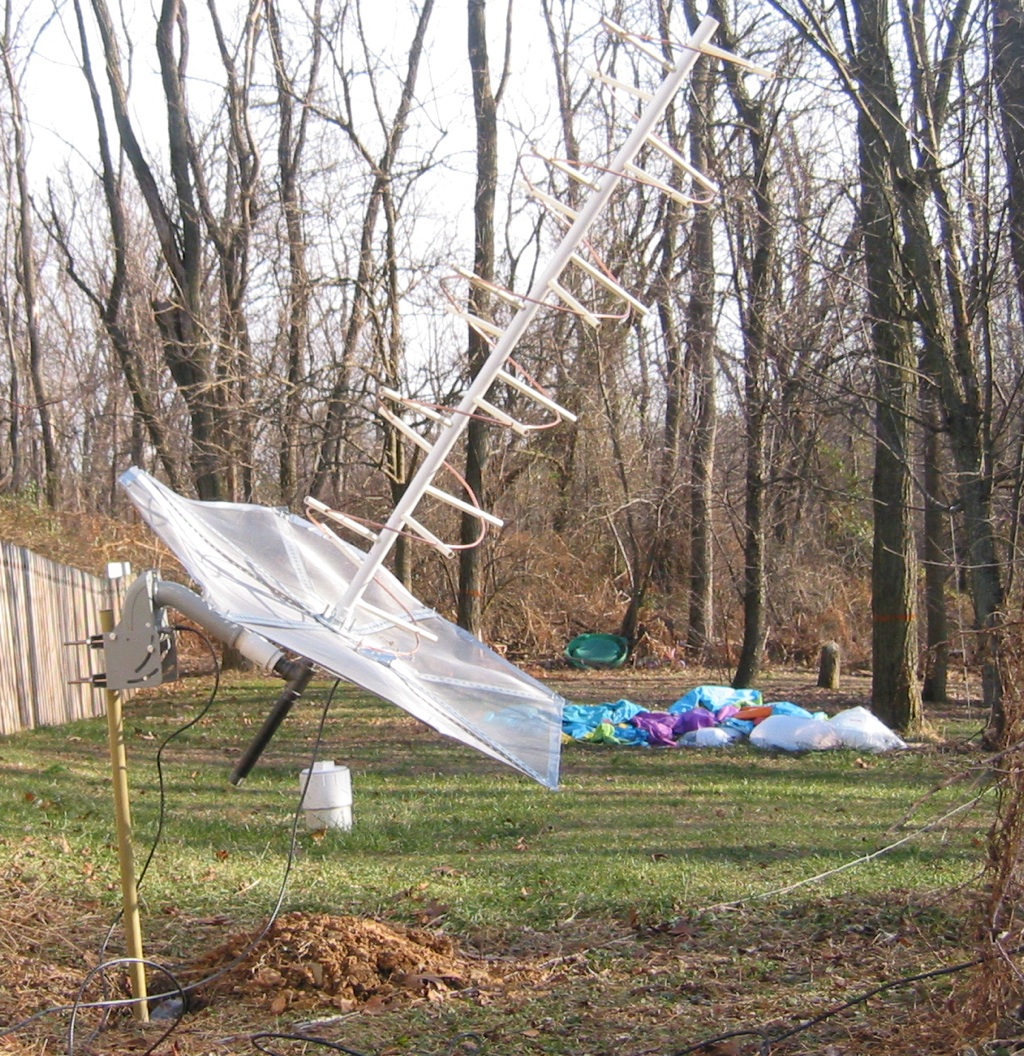
The angle of the motor is adjusted based on the latitude of the receiving site, so that as the motor turns the satellite tracks across the geostationary orbit.
Signal Levels of Radio True North’s May 14th Transmission on 6950 kHz
The graph below shows the received signal levels of Radio True North, a pirate radio station from Canada, which transmitted on 6950 kHz on Mary 14, 2012. The signal faded in at around 0200 UTC, and the transmitter was switched off at 0702 UTC – that can plainly be seen on the chart:
You can also see that after the transmitter switched off, the received signal levels were about -85 dBm, that is the background noise level. At peak, the signal was about -75 dBm, just a hair under S9. The signal to noise ratio is the difference between the signal and noise levels, or 10 dB.
Here is a short recording taken at around 0516 UTC, so you can hear what this signal sounds like. Remember, it is around S9, but the signal to noise ratio, which is what really matters, is only 10 dB. We had rain/thunder storms all along the east coast during this time.
Signal to noise ratios were discussed an earlier post, coincidently enough called Signal To Noise Ratios. There’s some simulated SNR recordings there. The 10 dB example sounds very close to the RTN recording above.
RTN was using his “usual power” (we’ll be vague and say a few hundred watts). Had he been using a lower power level, say 10 watts, the signal to noise ratio would have been about 0 dB, if not negative. He’s using a delta loop antenna, and is about 4,000 km (2,500 miles) away from my location.
Here’s a graph of RTN’s carrier frequency, as measured here:
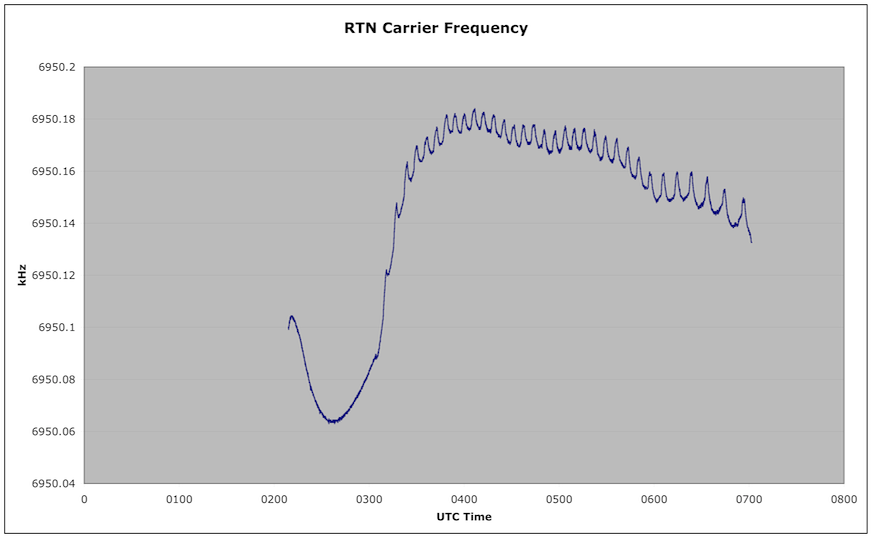
You can observe both the power on drift, and short term cycling (about every 10 minutes) due to most likely to something thermal, perhaps a fan.
UHF Pirates – 250 MHz SATCOM Monitoring
UHF SATCOM refers to satellite repeaters that operate between 240 MHz and 270 MHz. To receive SATCOM, you need a receiver that can tune the frequency range in narrow FM (most modern scanners can do this). You also need an outside antenna, and possibly a LNA preamp.
The satellites in question are operated by the US military. They are essentially repeaters in geostationary orbit. Because they are open (no access control) they are often used by third parties, most often by people in Brazil. It is very common to hear Portuguese transmissions. One listener, who spent several years living in Brazil, described it as
Portuguese slang spoken by people who never paid attention in school
Back in 2009, 39 Brazilian pirates were busted, but the activity continues.
Here’s a recording of SATCOM pirates, and another recording of SATCOM pirates
255.550 MHz is very heavily used by the Brazilian pirates. As I am typing this, I am also hearing pirates on 253.500, 253.750, and 262.190 MHz.
There is an excellent breakdown of all of the 250 MHz SATCOM Transponders By Satellite
While you can start with a basic outdoor scanner antenna, such as a discone antenna or other scanner antenna
, many serious listeners eventually build a directional antenna, such as a helical. I will have construction information about one that I built in a future article.
Next, since the signal levels are often very weak, the use of a LNA preamp is highly recommended. I built one of the Down East Microwave Inc. GaAs pHEMT pre amp kits, and find that it really helps a lot.
Digital Radio Mondiale
Have you run across an odd sounding digital transmission in one of the SWBC bands? Possibly, you heard a DRM transmission. Digital Radio Mondiale (DRM) is a digital audio broadcasting technology that claims to provide FM quality sound over shortwave radio. It uses MPEG-4 codecs.
Here is an example of a DRM signal. This one is Vatican Radio on 17815 kHz at 1610 UTC on May 5, 2012. First, the digital transmission as you would hear it tuned on a regular SW radio: DRM signal
Below is a waterfall showing the DRM signal, between two traditional AM transmissions:
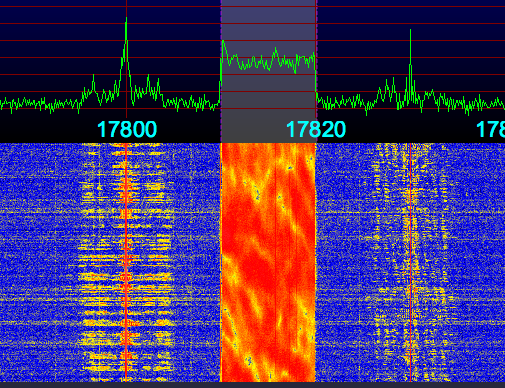
Comparing the transmissions, you can see how easy it is to distinguish a DRM transmission from a regular AM transmission. The signal intensity is pretty much constant over the entire 10 kHz bandwidth, and there is no strong carrier in the center, with the symmetrical sidebands around it.
Below is a zoom into the entire DRM signal:
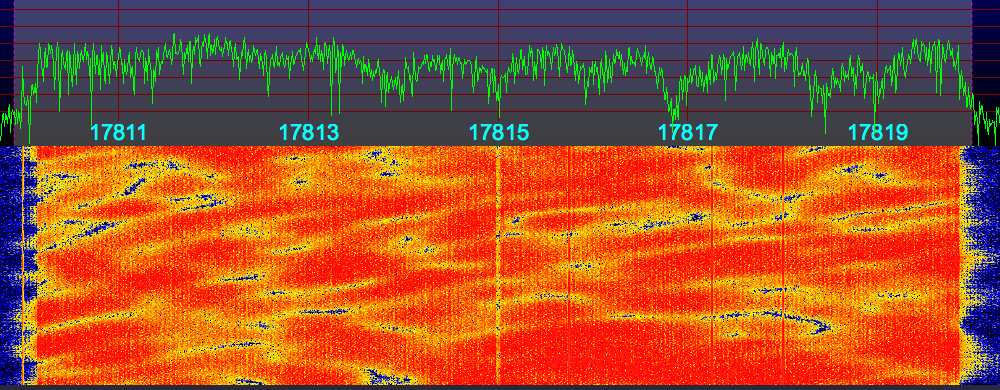
And here is what the resulting audio sounds like, after being processed by DRM software: DRM audio
For this reception, I used a netSDR receiver with a 635 ft sky loop antenna, running the SdrDx software. SdrDx was set to USB mode with a 10 kHz wide filter, since the DRM transmissions are 10 kHz wide. The output of SdrDx was fed through Soundflower (a virtual sound device) to Dream, which does the DRM decoding.
Below is the main Dream window, showing some basic information about the DRM signal, such as the name of the station, target area, etc. This is all obtained from the DRM signal itself. The audio bitrate is also displayed. There is only one audio channel on this transmission, there could be multiple channels.
The next window shows some detailed information about the DRM transmission, such as the signal to noise ratio, various decoding parameters and settings, a graph of the SNR, etc:
One thing to remember about DRM, it is like most digital transmissions – all or nothing. If the reception quality of the DRM signal is poor, the audio will completely cut out. So when reception is good, you get great audio. When it is poor, you get nothing.
Another point, about Dream itself. It is the poster child of open sores software. There’s no OS X binary on the download site. Download the source code, hunt around for zillions of libraries, compile and link the app (Wait! You’re not a programmer, you just want to use the app? Tough luck, kid). Lather, rinse repeat.
I did find a binary download link for Dream for Mac OS X here. It’s from 2009, but it seems to mostly work.
There is a DRM encoder called Spark. I am not aware of any pirates that have tried using DRM in their transmissions. They’d need a transmitter that can handle very wide (at least 10 kHz) audio in SSB mode. There are some lower quality DRM formats that use 4.5 and 5 kHz wide transmissions, with resulting lower quality audio. It might be an interesting experiment for some of the the more technically minded ops.
A good source for up to date DRM transmission schedules is the Shortwave Broadcast Schedules app, available for both the iPhone/iPad and Android. DRM transmissions are identified with the word DIGITAL in the station name.

